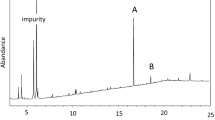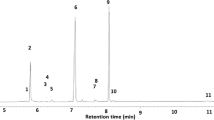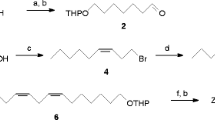Abstract
Analyses of extracts of pheromone glands and of volatiles from calling female fall armyworm moths,Spodoptera frugiperda (J.E. Smith), revealed the presence of the following compounds: dodecan-1-ol acetate, (Z)-7-dodecen-1-ol acetate, 11-dodecen-1-ol acetate, (Z)-9-tetradecenal, (Z)-9-tetradecen-1-ol acetate, (Z)-11-hexadecenal, and (Z)-11-hexadecen-1-ol acetate. The volatiles emitted by calling females differed from the gland extract in that the two aldehydes were absent. Field tests were conducted with sticky traps baited with rubber septa formulated to release blends with the same component ratios as those emitted by calling females. These tests demonstrated that both (Z)-7-dodecen-1-ol acetate and (Z)-9-tetradecen-1-ol acetate are required for optimum activity and that this blend is a significantly better lure than either virgin females or 25 mg of (Z)-9-dodecen-1-ol acetate in a polyethylene vial, the previously used standard. Addition of the other three acetates found in the volatiles did not significantly increase the effectiveness of the two-component blend as a bait for Pherocon 1C or International Pheromones moth traps.
Similar content being viewed by others
References
Andrews, K.L. 1980. The whorlworm,Spodoptera frugiperda, in Central America and neighboring areas.Fla. Entomol. 63:456–467.
Burton, R.L. 1969. Mass rearing the corn earworm in the laboratory. U.S. Dep. Agric. Tech. Bull. ARS-33-134, 8 pp.
Cross, J.H. 1980. A vapor collection and thermal desorption method to measure semiochemical release rates from controlled release formulations.J. Chem. Ecol. 6:781–787.
Cross, J.H., Byler, R.C., Cassidy, R.F., Silverstein, R.M., Greenblatt, R.E., Burkholder, W.E., Levinson, A.R., andLevinson, H.Z. 1976. Porapak-Q collection of pheromone components and isolation of (Z)- and (E)-14-methyl-8-hexadecenal, sex pheromone components from the females of four species ofTrogoderma (Coleoptera: Dermestidae).J. Chem. Ecol. 2:457–468.
Duncan, J.H. 1955. Multiple-range and multiple-F tests. Biometrics 11:1–42.
Grob, K., andZürcher, F. 1976. Stripping of trace organic substances from water. Equipment and procedures.J. Chromatogr. 117:285–294.
Heath, R.R., andDoolittle, R.E. 1983. Derivatives of cholesteryl cinnamate: A comparison of the separations of geometrical isomers when used as gas chromatographic stationary phases.J. HRC CC 6:16–19.
Heath, R.R., andTumlinson, J.H. 1986. Correlation of retention times on a liquid crystal capillary column with reported vapor pressures and half-lives of compounds used in pheromone formulations.J. Chem. Ecol. 12:2081–2088.
Heath, R.R., Tumlinson, J.H., Doolittle, R.E., andDuncan, J.H. 1977. Analytical and preparative separation of geometrical isomers by high efficiency silver nitrate liquid chromatography.J. Chromatogr. Sci. 15:10–13.
Heath, R.R., Jordan, J.R., Sonnet, P.E., andTumlinson, J.H. 1979. Potential for the separation of insect pheromones by gas chromatography on columns coated with cholesteryl cinnamate, a liquid-crystal phase.J. HRC CC 2:712–714.
Heath, R.R., Burnsed, G.E., Tumlinson, J.H., andDoolittle, R.E. 1980. Separation of a series of positional and geometrical isomers of olefinic aliphatic primary alcohols and acetates by capillary gas chromatography.J. Chromatogr., 189:199–208.
Heath, R.R., Teal, P.E.A., Tumlinson, J.H., andMengelkoch, L.J. 1986. Prediction of release of multicomponent pheromone blends from rubber septa: A first approximation using relative vapor pressure calculated from retention indices on a liquid crystal column.J. Chem. Ecol. 12:2133–2143.
Hill, A.S., Cardé, R., Kido, A., andRoelofs, W.L. 1975. Sex pheromone of the orange tortrix mothArgyrotaemia citrana (Lepidoptera: Tortricidae).J. Chem. Ecol. 1:215–224.
Jones, R.L., andSparks, A.N. 1979. (Z)-9-Tetradecen-1-ol acetate: A secondary sex pheromone of the fall armyworm,Spodoptera frugiperda (J.E. Smith).J. Chem. Ecol. 5:721–725.
Mitchell, E.R. 1978. Monitoring adult populations of the fall armyworm.Fla. Entomol. 62:91–98.
Mitchell, E.R., andDoolittle, R.E. 1976. Sex pheromones ofSpodoptera exigua, S. eridania, andS. frugiperda: Bioassay for field activity.J. Econ. Entomol. 69:324–326.
Mitchell, E.R., andMcLaughlin, J.R. 1982. Suppression of mating and oviposition by fall armyworm and mating by corn earworm in corn, using the air permeation technique.J. Econ. Entomol. 75:270–273.
Mitchell, E.R., Sugie, H., andTumlinson, J.H. 1983. Rubber septa as a dispenser for the fall armyworm sex attractant.J. Environ. Sci. Health A18:463–470.
Mitchell, E.R., Tumlinson, J.H., andMcNeil, J.N. 1985. Field evaluation of commercial pheromone formulations and traps using a more effective sex pheromone blend for the fall armyworm (Lepidoptera: Noctuidae).J. Econ. Entomol. 78:1364–1369.
Sekul, A.A., andSparks, A.N. 1967. Sex pheromone of the fall armyworm moth: Isolation, identification, and synthesis.J. Econ. Entomol. 60:1270–1272.
Sekul, A.A., andSparks, A.N. 1976. Sex attractant of the fall armyworm moth. USDA Tech. Bull. 1542, 6 pp.
Sparks, A.N. 1980. Pheromones: Potential for use in monitoring and managing populations of the fall armyworm.Fla. Entomol. 63:406–410.
Steel, R.G.D., andTorrie, J.H. 1960. Principles and Procedures of Statistics. McGraw-Hill, New York, 481 pp.
Tumlinson, J.H.,Heath, R.R., andTeal, P.E.A. 1982. Analysis of chemical communications systems of Lepidoptera, pp. 1–25,in B.A. Leonhardt and M. Beroza (eds.). Insect Pheromone Technology: Chemistry and Applications. American Chemical Society Symposium Series, No. 190.
Author information
Authors and Affiliations
Additional information
Mention of a commercial or proprietary product does not constitute an endorsement by the USDA.
Rights and permissions
About this article
Cite this article
Tumlinson, J.H., Mitchell, E.R., Teal, P.E.A. et al. Sex pheromone of fall armyworm,Spodoptera frugiperda (J.E. Smith). J Chem Ecol 12, 1909–1926 (1986). https://doi.org/10.1007/BF01041855
Received:
Accepted:
Issue Date:
DOI: https://doi.org/10.1007/BF01041855




